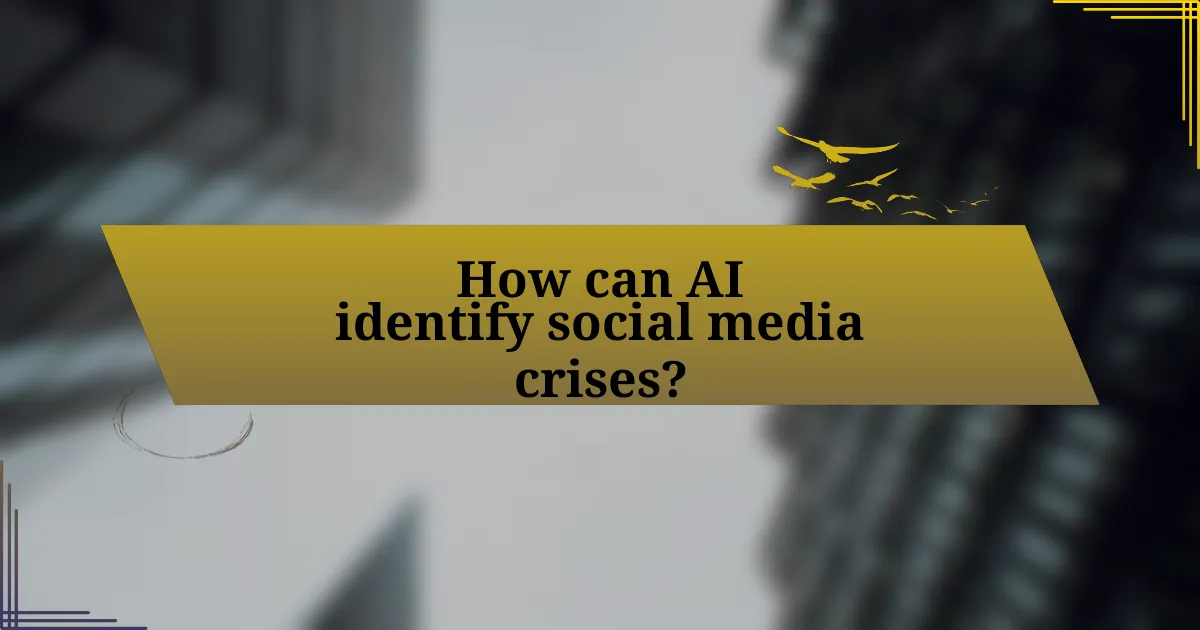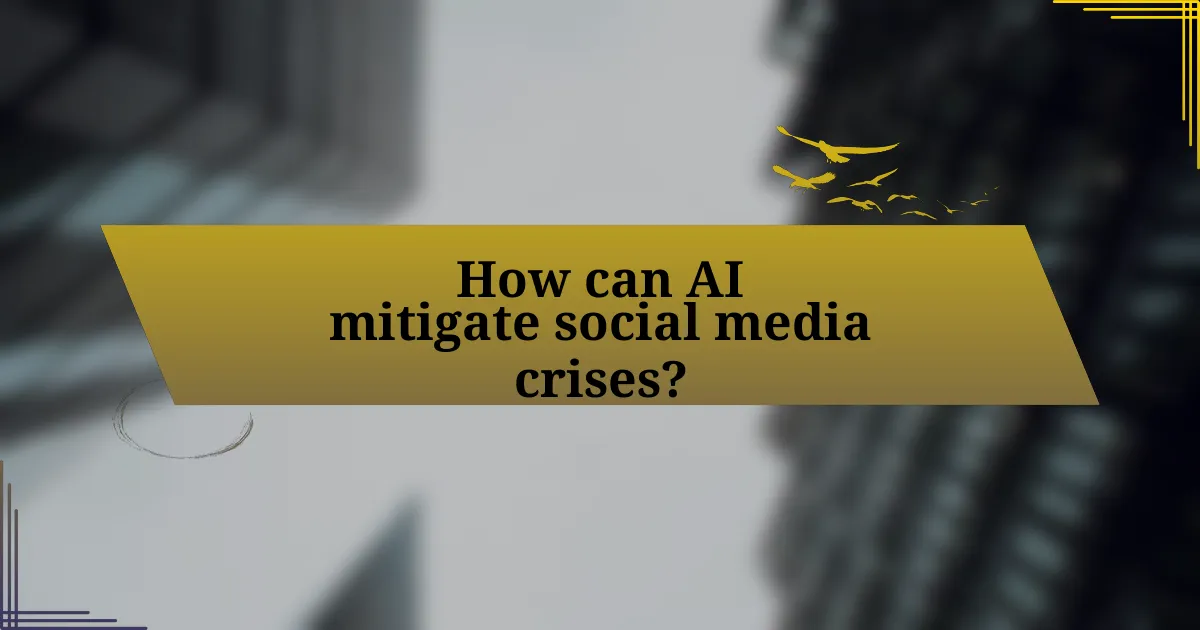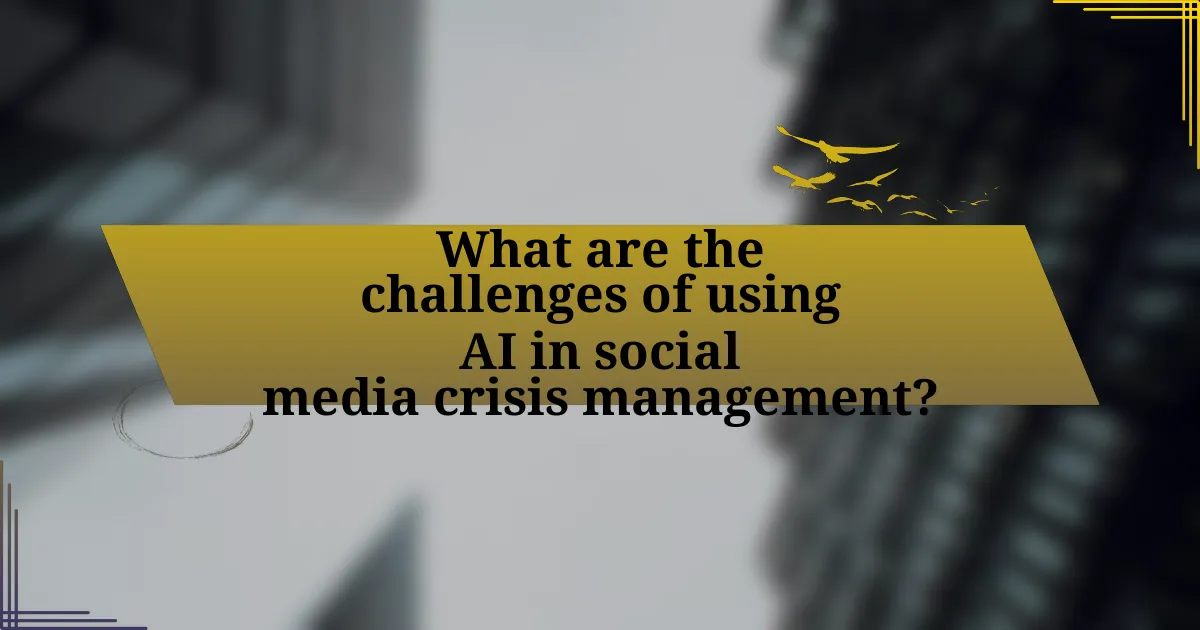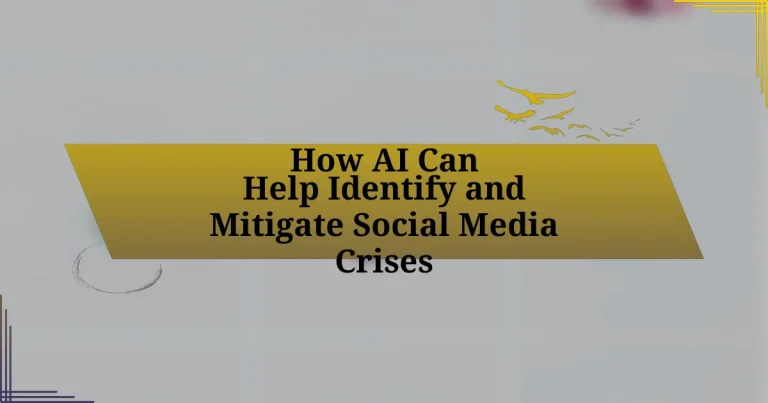The article focuses on how artificial intelligence (AI) can identify and mitigate social media crises. It outlines the methods AI employs, such as natural language processing (NLP) and machine learning algorithms, to analyze data for patterns of negative sentiment and unusual activity. The discussion includes the types of crises AI can detect, such as misinformation and brand reputation issues, and the technologies that enable effective crisis management. Additionally, it addresses the challenges and limitations of AI in accurately identifying crises, emphasizing the importance of human oversight and best practices for leveraging AI in crisis management strategies.

How can AI identify social media crises?
AI can identify social media crises by analyzing large volumes of data for patterns indicative of negative sentiment, unusual spikes in activity, or the emergence of specific keywords associated with crises. Natural Language Processing (NLP) techniques enable AI to assess the sentiment of posts, comments, and shares, allowing it to detect shifts in public perception. For instance, a study by the Pew Research Center found that 64% of Americans believe social media platforms play a significant role in shaping public opinion, highlighting the importance of monitoring these channels for potential crises. Additionally, machine learning algorithms can track engagement metrics and identify anomalies, such as sudden increases in negative comments or shares, which often signal a brewing crisis.
What types of social media crises can AI detect?
AI can detect various types of social media crises, including misinformation, brand reputation issues, customer service failures, and emerging trends of negative sentiment. Misinformation crises arise when false information spreads rapidly, potentially damaging public perception; AI algorithms can analyze patterns and flag such content. Brand reputation issues occur when negative comments or reviews proliferate, and AI can monitor sentiment analysis to identify spikes in negative feedback. Customer service failures are detected through AI’s ability to analyze customer interactions and identify recurring complaints or dissatisfaction. Lastly, AI can recognize emerging trends of negative sentiment by tracking keywords and phrases across social media platforms, allowing organizations to respond proactively.
How does AI analyze sentiment to identify crises?
AI analyzes sentiment to identify crises by employing natural language processing (NLP) techniques to evaluate the emotional tone of social media content. This process involves algorithms that classify text as positive, negative, or neutral, allowing AI to detect spikes in negative sentiment that may indicate a potential crisis. For instance, a study by the Pew Research Center found that 64% of social media users have encountered negative comments, which can serve as early warning signals for organizations. By continuously monitoring social media platforms, AI can aggregate sentiment data, identify trends, and alert stakeholders to emerging crises, enabling timely intervention.
What role do keywords and trends play in crisis detection?
Keywords and trends are crucial in crisis detection as they enable the identification of emerging issues and public sentiment in real-time. By analyzing specific keywords associated with crises, organizations can monitor social media conversations and detect spikes in activity that may indicate a potential crisis. For instance, a study by the Pew Research Center found that 64% of social media users have encountered misinformation, highlighting the importance of tracking keywords related to false narratives. Additionally, trends in user engagement can signal shifts in public opinion, allowing organizations to respond proactively to mitigate the impact of a crisis.
What technologies enable AI to identify social media crises?
AI identifies social media crises through technologies such as natural language processing (NLP), machine learning algorithms, sentiment analysis, and real-time data analytics. NLP enables AI to understand and interpret human language, allowing it to detect negative sentiments or emerging issues in social media posts. Machine learning algorithms analyze patterns in data to predict potential crises based on historical trends. Sentiment analysis quantifies emotional tone in social media content, helping to gauge public reaction. Real-time data analytics processes vast amounts of social media data quickly, enabling timely identification of crises as they unfold. These technologies collectively enhance AI’s ability to monitor, analyze, and respond to social media crises effectively.
How do machine learning algorithms contribute to crisis identification?
Machine learning algorithms contribute to crisis identification by analyzing vast amounts of data from social media platforms to detect patterns indicative of emerging crises. These algorithms utilize natural language processing and sentiment analysis to evaluate user-generated content, identifying spikes in negative sentiment or specific keywords associated with crises. For instance, a study by the University of Southern California demonstrated that machine learning models could predict public health crises by analyzing Twitter data, achieving an accuracy rate of over 80%. This capability allows organizations to respond proactively to potential crises, thereby mitigating their impact.
What is the significance of natural language processing in this context?
Natural language processing (NLP) is significant in the context of identifying and mitigating social media crises because it enables the analysis of vast amounts of unstructured text data generated on social platforms. NLP algorithms can detect sentiment, identify emerging trends, and classify content related to potential crises in real-time. For instance, a study by the University of Southern California demonstrated that NLP techniques could accurately predict public sentiment shifts during crises, allowing organizations to respond proactively. This capability enhances situational awareness and facilitates timely interventions, ultimately reducing the impact of social media crises.

How can AI mitigate social media crises?
AI can mitigate social media crises by employing advanced algorithms to monitor, analyze, and respond to online conversations in real-time. These algorithms can detect emerging trends, sentiment shifts, and potential threats by analyzing vast amounts of data from various social media platforms. For instance, AI tools can identify spikes in negative sentiment or specific keywords associated with a crisis, allowing organizations to respond proactively. Research from the Journal of Business Research indicates that companies using AI-driven sentiment analysis can reduce response times by up to 50%, significantly minimizing the impact of a crisis.
What strategies does AI employ to manage crises once identified?
AI employs several strategies to manage crises once identified, including real-time monitoring, sentiment analysis, and automated response systems. Real-time monitoring allows AI to track social media platforms continuously, identifying emerging issues as they arise. Sentiment analysis helps AI gauge public opinion and emotional reactions, enabling organizations to understand the severity of the crisis. Automated response systems facilitate immediate communication, allowing organizations to address concerns swiftly and effectively. These strategies are supported by data analytics, which provide insights into user behavior and trends, ensuring that responses are timely and relevant.
How does AI facilitate real-time response during a crisis?
AI facilitates real-time response during a crisis by analyzing vast amounts of data quickly to identify emerging threats and disseminate critical information. For instance, AI algorithms can monitor social media platforms for keywords and patterns indicative of a crisis, enabling organizations to respond promptly. A study by the Massachusetts Institute of Technology found that AI can reduce response times by up to 50% in emergency situations by automating data collection and analysis. This capability allows for timely interventions, resource allocation, and communication with affected populations, ultimately enhancing crisis management effectiveness.
What role does automated content moderation play in crisis mitigation?
Automated content moderation plays a crucial role in crisis mitigation by swiftly identifying and removing harmful or misleading content from social media platforms. This technology utilizes algorithms to analyze user-generated content in real-time, enabling platforms to respond promptly to potential crises, such as misinformation or hate speech. For instance, a study by the Pew Research Center found that platforms employing automated moderation can reduce the spread of false information by up to 70%, thereby minimizing the impact of crises on public perception and safety.
How can AI assist in communication during a social media crisis?
AI can assist in communication during a social media crisis by enabling real-time monitoring and analysis of online conversations. This technology allows organizations to quickly identify emerging issues, sentiment shifts, and key influencers discussing the crisis. For instance, AI algorithms can analyze vast amounts of social media data to detect spikes in negative sentiment, enabling timely responses. According to a study by the Pew Research Center, 64% of social media users expect brands to respond to crises within an hour, highlighting the importance of rapid communication facilitated by AI tools. Additionally, AI-driven chatbots can provide immediate responses to customer inquiries, ensuring that accurate information is disseminated quickly, which helps to mitigate misinformation and maintain trust.
What are the best practices for AI-generated responses?
The best practices for AI-generated responses include ensuring clarity, relevance, and accuracy in the information provided. Clarity is achieved by using straightforward language and avoiding jargon, which helps users understand the response easily. Relevance is maintained by tailoring responses to the specific context of the inquiry, particularly in social media crisis situations where timely and pertinent information is crucial. Accuracy is critical, as AI-generated responses must be based on verified data to prevent misinformation, especially during crises. For instance, a study by the Pew Research Center highlights that 64% of social media users believe that misinformation is a significant problem, underscoring the need for precise AI responses.
How can AI help in crafting effective messaging to stakeholders?
AI can help in crafting effective messaging to stakeholders by analyzing data to identify key concerns and preferences. By utilizing natural language processing and sentiment analysis, AI can assess stakeholder feedback and social media interactions, allowing organizations to tailor their messages for clarity and relevance. For instance, a study by McKinsey & Company found that companies leveraging AI for customer insights improved their communication effectiveness by 20%. This data-driven approach ensures that messaging resonates with stakeholders, addressing their specific needs and enhancing engagement.

What are the challenges of using AI in social media crisis management?
The challenges of using AI in social media crisis management include issues related to data accuracy, context understanding, and ethical considerations. AI systems often struggle with interpreting the nuances of human language, leading to misinterpretations of sentiment or intent, which can exacerbate a crisis rather than mitigate it. For instance, a study by the Pew Research Center found that AI algorithms can misclassify posts, resulting in inappropriate responses during critical situations. Additionally, the reliance on historical data can introduce biases, as AI may not account for emerging trends or unique circumstances surrounding a specific crisis. Ethical concerns also arise regarding privacy and the potential for misuse of data, which can undermine public trust in organizations using AI for crisis management.
What limitations does AI face in accurately identifying crises?
AI faces significant limitations in accurately identifying crises due to challenges in understanding context, nuances in language, and the variability of human behavior. These limitations arise because AI systems often rely on algorithms that may misinterpret sarcasm, irony, or cultural references, leading to false positives or negatives in crisis detection. For instance, a study by the MIT Media Lab found that AI struggled with sentiment analysis in emotionally charged contexts, which is critical for recognizing crises. Additionally, the dynamic nature of social media means that crises can evolve rapidly, and AI may not adapt quickly enough to changing narratives or emerging trends.
How can biases in AI algorithms affect crisis detection?
Biases in AI algorithms can significantly impair crisis detection by skewing the identification and interpretation of relevant data. When algorithms are trained on biased datasets, they may overlook or misinterpret critical signals indicative of a crisis, leading to delayed or inadequate responses. For instance, if an algorithm is predominantly trained on data from specific demographics, it may fail to recognize crises affecting underrepresented groups, resulting in a lack of timely intervention. Studies have shown that biased algorithms can exacerbate existing inequalities, as evidenced by research from the AI Now Institute, which highlights how biased data can lead to systemic failures in crisis management.
What are the risks of over-reliance on AI in crisis situations?
Over-reliance on AI in crisis situations can lead to significant risks, including the potential for misinformation, lack of human judgment, and system failures. Misinformation can arise when AI algorithms misinterpret data or generate inaccurate responses, which can exacerbate a crisis rather than mitigate it. The absence of human judgment may result in critical decisions being made without the necessary context or ethical considerations, as AI lacks the ability to understand nuances in human behavior and societal impacts. Additionally, system failures, such as software bugs or cyberattacks, can render AI tools ineffective during crucial moments, leading to delayed responses and increased harm. These risks highlight the importance of maintaining a balanced approach that integrates human oversight with AI capabilities in crisis management.
How can organizations overcome these challenges?
Organizations can overcome challenges related to social media crises by implementing AI-driven monitoring systems that analyze real-time data for sentiment and trends. These systems enable organizations to detect potential crises early, allowing for timely responses. For instance, a study by the Pew Research Center found that 64% of social media users have experienced online harassment, highlighting the need for proactive measures. By utilizing AI tools, organizations can automate the identification of negative sentiment and engage with affected users swiftly, thereby mitigating the impact of crises effectively.
What strategies can be implemented to improve AI accuracy?
To improve AI accuracy, implementing strategies such as enhancing data quality, optimizing algorithms, and conducting regular model evaluations is essential. High-quality, diverse, and representative datasets reduce bias and improve the model’s ability to generalize across different scenarios. For instance, using techniques like data augmentation can increase the volume and variety of training data, leading to better performance. Additionally, optimizing algorithms through hyperparameter tuning and selecting appropriate model architectures can significantly enhance predictive accuracy. Regular evaluations, including cross-validation and performance metrics analysis, ensure that the AI model remains effective and adapts to new data trends. These strategies collectively contribute to a more accurate AI system capable of effectively identifying and mitigating social media crises.
How can human oversight enhance AI’s effectiveness in crisis management?
Human oversight can enhance AI’s effectiveness in crisis management by ensuring that AI systems are guided by human judgment and contextual understanding. This oversight allows for the interpretation of nuanced situations that AI may misinterpret, such as cultural sensitivities or emotional responses during a crisis. For instance, during the COVID-19 pandemic, human analysts were crucial in evaluating AI-generated data to identify misinformation trends on social media, leading to more accurate responses and interventions. This collaboration between human expertise and AI capabilities results in more effective crisis management strategies, as evidenced by improved decision-making processes in real-time scenarios.
What are the best practices for leveraging AI in social media crisis management?
The best practices for leveraging AI in social media crisis management include real-time monitoring, sentiment analysis, automated response systems, and predictive analytics. Real-time monitoring allows organizations to track mentions and discussions across social media platforms, enabling them to identify potential crises as they emerge. Sentiment analysis utilizes natural language processing to gauge public sentiment, helping organizations understand the emotional tone of conversations and prioritize responses accordingly. Automated response systems can provide immediate replies to common inquiries, reducing response time and mitigating negative sentiment. Predictive analytics can forecast potential crises by analyzing historical data and trends, allowing organizations to prepare proactive strategies. These practices enhance an organization’s ability to respond effectively and efficiently during social media crises.
How can organizations integrate AI tools into their crisis management plans?
Organizations can integrate AI tools into their crisis management plans by utilizing AI-driven analytics to monitor social media platforms for real-time sentiment analysis and emerging trends. This integration allows organizations to identify potential crises early by analyzing large volumes of data, including user-generated content and engagement metrics. For instance, a study by the Pew Research Center found that 69% of adults in the U.S. use social media, making it a critical channel for crisis detection. By employing machine learning algorithms, organizations can automate the detection of negative sentiment and flag potential issues before they escalate, thereby enhancing their response strategies and improving overall crisis management effectiveness.
What metrics should be used to evaluate AI’s performance in crisis situations?
To evaluate AI’s performance in crisis situations, key metrics include accuracy, response time, and sentiment analysis effectiveness. Accuracy measures how correctly the AI identifies and categorizes crisis-related content, which is crucial for timely interventions. Response time assesses how quickly the AI can analyze data and provide actionable insights, impacting the overall effectiveness of crisis management. Sentiment analysis effectiveness evaluates the AI’s ability to gauge public sentiment during a crisis, informing stakeholders about the emotional landscape and guiding communication strategies. These metrics are essential for ensuring that AI tools are reliable and effective in managing social media crises.

